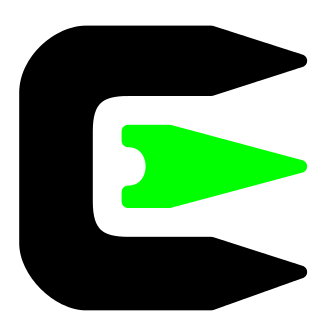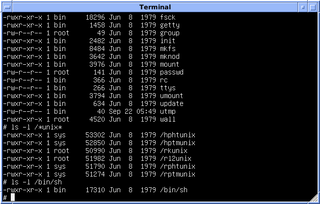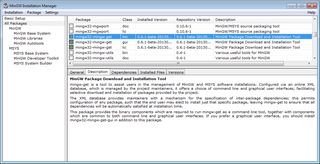
Bash is a Unix shell and command language written by Brian Fox for the GNU Project as a free software replacement for the Bourne shell. The shell's name is an acronym for Bourne-Again SHell, a pun on the name of the Bourne shell that it replaces and the notion of being "born again". First released in 1989, it has been used as the default login shell for most Linux distributions and it was one of the first programs Linus Torvalds ported to Linux, alongside GCC. It is available on nearly all modern operating systems.

Cygwin is a Unix-like environment and command-line interface for Microsoft Windows.

A shell script is a computer program designed to be run by a Unix shell, a command-line interpreter. The various dialects of shell scripts are considered to be scripting languages. Typical operations performed by shell scripts include file manipulation, program execution, and printing text. A script which sets up the environment, runs the program, and does any necessary cleanup or logging, is called a wrapper.

A Unix shell is a command-line interpreter or shell that provides a command line user interface for Unix-like operating systems. The shell is both an interactive command language and a scripting language, and is used by the operating system to control the execution of the system using shell scripts.

A man page is a form of software documentation usually found on a Unix or Unix-like operating system. Topics covered include computer programs, formal standards and conventions, and even abstract concepts. A user may invoke a man page by issuing the man command.

The Bourne shell (sh) is a shell command-line interpreter for computer operating systems.
Almquist shell is a lightweight Unix shell originally written by Kenneth Almquist in the late 1980s. Initially a clone of the System V.4 variant of the Bourne shell, it replaced the original Bourne shell in the BSD versions of Unix released in the early 1990s.

The GNU Autotools, also known as the GNU Build System, is a suite of programming tools designed to assist in making source code packages portable to many Unix-like systems.
Unix security refers to the means of securing a Unix or Unix-like operating system. A secure environment is achieved not only by the design concepts of these operating systems, but also through vigilant user and administrative practices.

MinGW, formerly mingw32, is a free and open source software development environment to create Microsoft Windows applications.
On POSIX-compliant platforms, SIGHUP is a signal sent to a process when its controlling terminal is closed. It was originally designed to notify the process of a serial line drop. SIGHUP is a symbolic constant defined in the header file signal.h.
The PWB shell was a Unix shell.
ProTERM is a terminal emulator and modem program for the Apple II and Macintosh lines of personal computers, published by Intrec Software. Most popular in the late 1980s and 1990s, it was most commonly used for calling bulletin board systems (BBSes) via a computer's modem, experienced users could also Telnet into Unix server and shell account thereon and FTP and tunneling to various destinations therefrom, and once logged into a Unix shell account, other forms of telecom all across the pre-Web Internet; via VT100 terminal emulator or ANSI art, this later ushered in Graphics to the scene.
HeaderDoc is a documentation generator developed and maintained by Apple Inc. Using specially commented source code files as input, HeaderDoc generates documentation for the code in HTML or XML format. Syntax for HeaderDoc comment tags is largely similar to, and as of HeaderDoc version 8, supportive of Javadoc tags. HeaderDoc 8.7 and later also provides partial support for many Doxygen tags. Apple's HeaderDoc project is free, open source software distributed under the Apple Public Source License.
In Unix and Unix-like operating systems, job control refers to control of jobs by a shell, especially interactively, where a "job" is a shell's representation for a process group. Basic job control features are the suspending, resuming, or terminating of all processes in the job/process group; more advanced features can be performed by sending signals to the job. Job control is of particular interest in Unix due to its multiprocessing, and should be distinguished from job control generally, which is frequently applied to sequential execution.
The script command is a Unix utility that records a terminal session. It dates back to the 1979 3.0 Berkeley Software Distribution (BSD).

A Unix-like operating system is one that behaves in a manner similar to a Unix system, although not necessarily conforming to or being certified to any version of the Single UNIX Specification. A Unix-like application is one that behaves like the corresponding Unix command or shell. Although there are general philosophies for Unix design, there is no technical standard defining the term, and opinions can differ about the degree to which a particular operating system or application is Unix-like.

Madagascar is a software package for multidimensional data analysis and reproducible computational experiments.

A command-line interface (CLI) is a means of interacting with a computer program by inputting lines of text called command-lines. Command-line interfaces emerged in the mid-1960s, on computer terminals, as an interactive and more user-friendly alternative to the non-interactive interface available with punched cards.
The POSIX terminal interface is the generalized abstraction, comprising both an application programming interface for programs, and a set of behavioural expectations for users of a terminal, as defined by the POSIX standard and the Single Unix Specification. It is a historical development from the terminal interfaces of BSD version 4 and Seventh Edition Unix.











